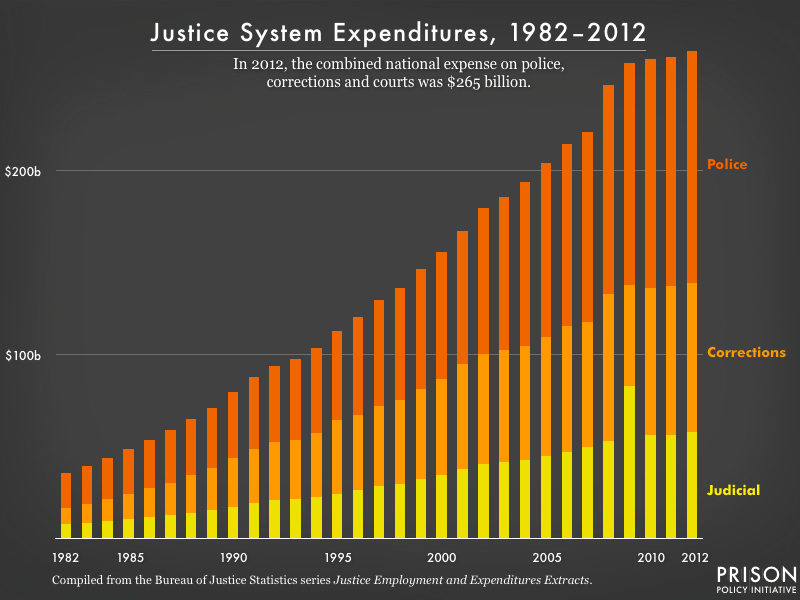Breaking Down the Costs of the Prison System
By Alex Schultz
How much is actually spent on food in prisons? On utilities? How much does health care cost for each inmate? Questions like these help paint a better picture of where taxpayers’ dollars are heading towards in our massive prison industrial complex which makes other countries’ prison systems appear miniscule. In this blog post, we will be looking at the cost of prison, similar to the last post besides the extensive breakdown to understand where all of this money is headed.
A lot of politicians think that the cause of this enormous budget is construction and actual day-to-day care of inmates, but in reality it is the courts, judicial system, correctional officers, and employees of the prison that are costing the most amount of money.
The Bureau of Justice Statistics reported that expenditures at all levels of prison in the judicial and legal system was $57.9 billion in 2012. This means that before inmates step foot in their prison cell, so about 30 percent of the spending on our prison industrial complex was just to get these citizens within the four walls they are supposed to be in. This is a result of many events and trends that have happened in our recent history. Judges all across the country have had an increased workload since the War on Crime & Drugs in the 1960s & 1970s and the judicial process has been taking months and sometimes years to escape, which only piles the costs of our justice system.

But there’s also those people who run the prison, right? Well, of course the maintenance of 2.3 million inmates in America’s prisons takes an intense policing system which requires copious amounts of money. The Bureau of Justice Statistics estimated the ratio of officers to inmates at 3.3 to 1, meaning there are on average 33 inmates for every 10 officers. Federal, state, and local prisons spent a total of $126.4 billion in 2012 on policing and maintaining the prison’s safety, as well as those outside the prison. Safety of the complexes is of upmost importance, but what’s even more important is something we all can’t live without. Food.
Everyone in the prison system has to eat. While it was a little difficult to find data on how much money prisons spent on food, I was able to find government published state prison data from 2001 detailing each expenditure. Food expense is labeled as “food service” and cost $1.2 billion dollars, around 5% of the total state prison expenditures. In 2001, there were 1.4 million inmates in America’s prisons. Dividing the food expense ($1.2 billion) by the amount of state prisoners (1,249,038) and then creating a per-day scale, on average each prison spends only $2.63 on food per day per inmate. Some states are much worse, especially in the South where per-day food expense is $0.52 in North Carolina, $0.72 in Alabama, and $0.81 in Mississippi. Although, looking into why this is the case, I found that southern state prisons generated food of their own on prison-operated farms and therefore would not have to spend as much on food.
The Bottom Line
While the breakdown of prison expenditures can be very alarming, it does do the job of shedding light into what our government thinks matter most. The costliest piece of the prison budget is running the vast amounts of prisons we have in America, followed by correctional staff and police to keep the prisons under control. With this information, it is important to understand how much money can do what amount of progress when it comes to prison reform. A lot of politicians think that the cause of this enormous budget is construction and actual day-to-day care of inmates, but in reality it is the courts, judicial system, correctional officers, and employees of the prison that are costing the most amount of money. It is a shame that our prison complex is as large as it is because this money feels like it is going to waste. It feels like we can allocate our resources better to create better lives for the inmates in jail and after jail. While of course that won’t happen immediately, thinking of the long term is our biggest hope. Stopping the cycle of incarceration in communities starts with a change in the inmate who affects his or her family by going to prison in the first place.
Works Cited
Fisher, Christian. “How Many Correctional Officers Does It Take to Staff Jails?” Chron.com, 21 Nov. 2017, work.chron.com/many-correctional-officers-staff-jails-30263.html.
Jarrett, Valerie. “Why Are Incarceration Rates In The US So High Relative To Other Countries?” Forbes, Forbes Magazine, 1 July 2016, www.forbes.com/sites/quora/2016/07/01/why-are-incarceration-rates-in-the-us-so-high-relative-to-other-countries/#1b089201f836.
Kincade, Brian. “The Economics of the American Prison System.” SmartAsset, SmartAsset, 21 May 2018, smartasset.com/mortgage/the-economics-of-the-american-prison-system.
Shields, Michaela. “Post 2018-2019 Budget Bite: Alternatives to Incarceration.” Policy Matters Ohio, 16 Oct. 2017, www.policymattersohio.org/research-policy/quality-ohio/revenue-budget/budget-policy/post-2018-2019-budget-bite-alternatives-to-incarceration.
United States, Congress, The California Legislature’s Nonpartisan Fiscal and Policy Advisor. “Overview of the Judicial Branch Budget.” Overview of the Judicial Branch Budget, Legislative Analyst’s Office, 2017.
Wagner, Peter, and Bernadette Rabuy. “Following the Money of Mass Incarceration.” Prison Policy Initiative, Prison Policy Initiative, 25 Jan. 2017, www.prisonpolicy.org/reports/money.html.